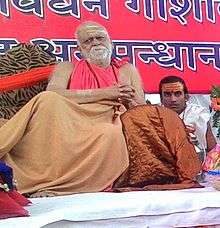Shankaracharya

Shankaracharya (IAST: Śaṅkarācārya, Shankara acharya) is a commonly used title of heads of monasteries called mathas in the Advaita Vedanta tradition. The title derives from Adi Shankara, an 8th-century CE reformer of Hinduism.[1] He is honored as Jagadguru, a title that was used earlier only to Krishna.
The popular view among historians is that there were four mathas (religious orders):
- The Dakshiānmnāya Sri Sharada Peetham (main matha) at Sringeri Sharada Peetham in Shringeri, Karnataka.
- The Uttarāmnāya matha (northern matha) at Jyotir Math in the city of Jyotirmath also known as Joshimath, Uttarakhand.
- The Pūrvāmnāya matha (eastern matha), or the Govardhana matha at Puri, Odisha.
- The Paśchimāmnāya matha (western matha), or the Dwaraka Pitha at Dwarka, Gujarat.
- Finally Sarvagna Peetham Kanchi Moolāmnāya Sri kanchi Kamakoti Peetham (Sarvjna Peetham), or the Kamakoti at Kanchipuram, Tamil Nadu
Shankaracharya is also seen as an avatar of Shiva (Shankara). Shankaracharya is responsible for founding many punyakshetras along the length and breadth of India, by taming avatars of Parvati and imprisoning her essence in Sri Chakras.
Adi Shankaracharya wished to grace the Indian subcontinent by establishing four major mathas in the four corners of the peninsula – north (Jyothirmath), south (Sringeri), east (Puri), west (Shāradā) – to propagate the philosophy of advaita vedanta and to promulgate the concept of Sanatana dharma, thus establishing dharma or righteousness, as the way of life of people. His primary four disciples took charges of each math and thus established a strong Guru-Sishya parampara (a lineage of masters-disciples) in every math, that continues to guide people to this day.
Further reading
- Mukhyananda, Swami (2006) Sri Shankaracharya: life and philosophy: An elucidative and reconciliatory interpretation, 4th ed.; OCLC 426914596; Kolkata; Advaita Ashrama
- Esoteric Buddhism by A.P. Sinnett, pp 81 ISBN 1438503652
See also
- Jayendra Saraswathi, Śaṅkarācārya of Kanchi Kamakoti Peetham
- Jagadguru of Sringeri Sharada Peetham
- Swāmī Abhinava Vidyā Tīrtha, Śaṅkarācārya of Śṛṅgeri
- Swāmī Bhāratī Tīrtha, Śaṅkarācārya of Śṛṅgeri
- Swāmī Bhāratīkṛṣṇa Tīrtha, scholar; mathematician; first Śaṅkarācārya to visit the West
- Swāmī Brahmānanda Sarasvatī, Śrīvidyā siddha; Śaṅkarācārya of Jyotirmāyā Pīṭha, Śaṅkara Matha, Badrināth
- Swāmī Swarupānanda Sarasvatī; Śaṅkarācārya of Jyotirmāyā Pīṭha, Śaṅkara Matha, Badrināth
- Swāmī Candrasekhara Bhāratī, Śaṅkarācārya of Śṛṅgeri
- Swāmī Saccidānanda Bhāratī, Śaṅkarācārya of Śṛṅgeri
- Swāmī Saccidānanda Bhāratī, Śaṅkarācārya of Śṛṅgeri
- Swāmī Saccidānanda Śivābhinava Nṛsiṁha Bhāratī, Śaṅkarācārya of Śṛṅgeri
- Swāmī Vidyāraṇya Tīrtha, Śaṅkarācārya of Śṛṅgeri
- Jagadguru of Ramachandrapura Matha - Sri Sri Raghaveshwara Bharati
References
- ↑ Aditya Thakur (1 November 2014). "Just A Handful Of Hindus Know Adi Shankaracharya Revived Their Religion". Topyaps. Retrieved 16 May 2014.
External links
| Wikimedia Commons has media related to Shankaracharyas. |